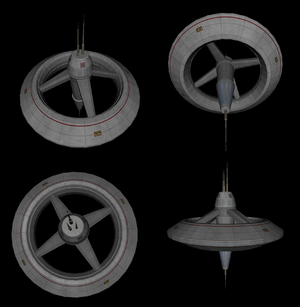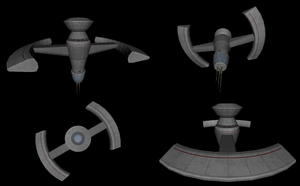

- Dimensions
- 12 x 10 x 10 meters
There are two primary kinds of automated defense satellites, photon torpedo and phaser turrets. The satellites are powered by fusion power cores, both, and have installed on them automated targeting computers to manage targets and deploy ordinance. They can also be controlled remotely from a command terminal (PADD or Tricorder for simple commands but a station or space vessel can take greater control.
Targeting Computer
The onboard computer is capable of managing thousands of targets and ranking those targets on priorities based on threat assessments and other programmable parameters. Most parameters have satellites give priority to protecting remote targets rather than themselves - this is not required but it is standard behavior. Satellites can also work in conjunction with each other networking over subspace communication links. This can allow remote satellites that do not have a positive lock on a target to release ordinance toward said target, relying on a closer satellite to relay guidance information to torpedoes.
Power Source
Each satellite has primary and secondary fusion power cores along with solar and battery power backups. While solar and battery power cannot fire the weapons effectively, they allow the satellite to be used as remote sensing stations even in lower power modes. The system is configured so that unless it is on alert the fusion cores remain inactive. Most cases the system uses passive sensing unless they are on alert or instructed specifically to go to an active mode.
Sensors
Sensors work in passive or active mode. In passive mode the sensor arrays look for anomalous readings from the information received from surrounding space, they do not emit any signals into space, relying on magnetic and gravitational sensors to determine if a ship or vessel is close enough to trigger an alert. They also have pre-programmed emissions signatures to identify likely targets in passive mode.
Active mode requires running the fusion reactor at a low power level and the sensor arrays broadcast an active signal and then read the information received from that signal. In active mode the sensors have increase range but are also more detectable themselves.
Passive / Active vs. Stealth
The final sensor mode is stealth mode. In this mode the satellites do not maintain a communication link with other satellites or command stations in the area, this maintains a very low sensor profile and allows them to remain undetected until activated. In this mode the satellites manages passive targeting awareness and proximity awareness but only becomes active if it receives a specifically coded signal beamed directly at the satellite.